The 1942 Mercury dime, often known as the Winged Liberty Head dime and part of the 90% silver coin series, is a favorite among collectors and dealers. The Mercury dime got its moniker due to Miss Liberty’s likeness to the ancient Roman god, Mercury.
What Is the 1942 Mercury Dime Made Of?
Following a call from US Mint Director Robert W. Woolley, the Mercury dime production period began in 1916. The Barber dimes, used from 1892 until 1916, would be replaced, and he intended to make a big modification to American coins.
The Mercury dime was produced for a total of 29 years. It comprises 90% Silver and 10% Copper, making them high-purity silver coins. It weighs 2.50 grams and has a diameter of 17.90 mm.
You can find rare 1942-proof Mercury dimes, representing a portion of the final proof production run for US coins before it resumed in 1950.
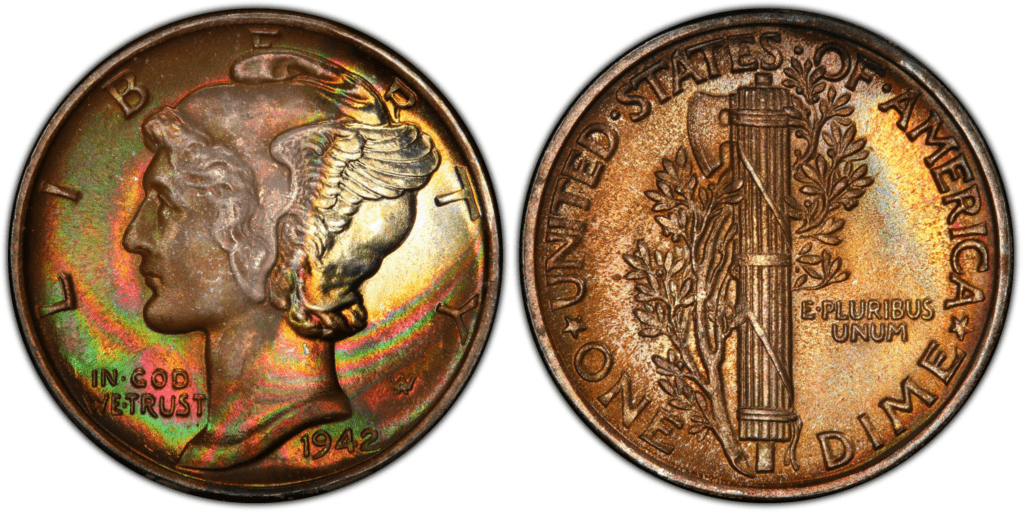
Adolph A. Weinman, the new dime’s designer, accepted the challenge in 1916 by adorning the front of the coin with a bust of Lady Liberty. Over the lady’s bust, in the center, was the word LIBERTY.
The date was placed directly beneath the Lady on the left side of the coin, below the renowned slogan IN GOD WE TRUST. Additionally, the letters “AW,” representing Weinman’s initials, can be seen next to Lady Liberty.
The reverse of the coin had a distinctive design that Weinman meticulously developed. An axe head and olive branches are positioned vertically in the center of a huge torch. The inscription E PLURIBUS UNUM is on the torch’s right side. Around the edge are the words UNITED STATES OF AMERICA on top and ONE DIME at the bottom. If there is a mint mark (“S” or “D”), it can be seen around the torch’s lower-left rim.
1942 Mercury Dime Varieties
The minting of this series began in 1916 and continued until 1945. Many people regard Adolph A. Weinman’s Mercury dimes to be among the most exquisite tiny coins ever produced in the United States of America.
Here is a summary of the Winged Liberty Head dimes minted in 1942:
| Series | Location Minted | Quantity Minted |
| 1942 P | Philadelphia | 205,410,000 |
| 1942 P (Proof) | Philadelphia | 22,329 |
| 1942 D | Denver | 60,740,000 |
| 1942 S | San Francisco | 49,300,000 |
| Total | 315,472,329 |
Here’s a deeper look at each of the 1942 Mercury dime varieties:
1942 P Mercury Dime
Edge: Reeded
Mint Mark: none
Place of minting: Philadelphia
Year of minting: 1942
Face Value: $0.10 (ten cents)
Price: $2.22 to $4.70 (Circulated condition)
Quantity produced: 205,432,329
Designer: Adolph Alexander Weinman
Composition: 90% Silver and 10% Copper
Mass: 2.50 grams
Diameter: 90 millimeters
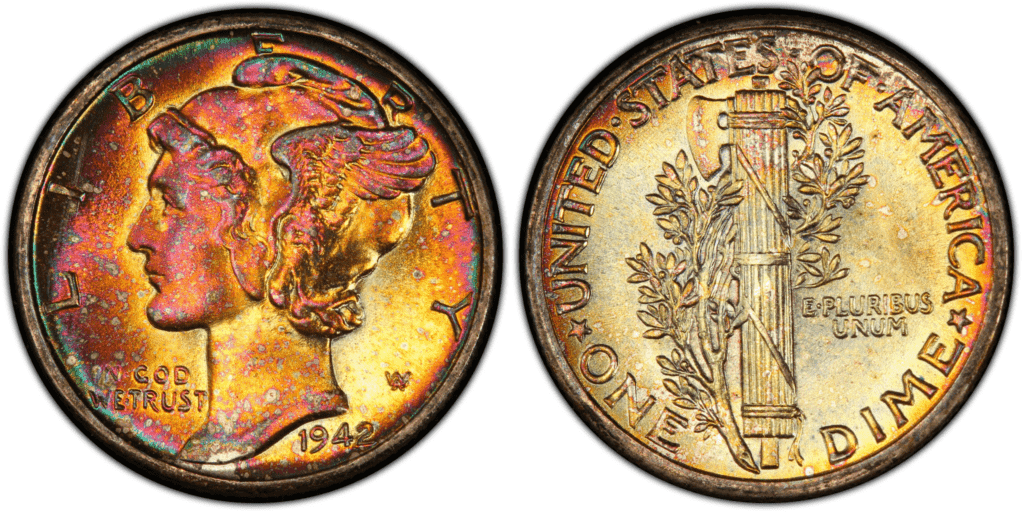
1942 (P) Winged Liberty Head (Mercury) dime frequently falls short of the Full Bands designation, as do all Philadelphia Mint dimes from the war years. On the plus side, 205,410,000 pieces of this issue were produced and kept in rolls, so obtaining a suitable specimen shouldn’t be a problem for collectors.
1942 Mercury dimes appear devoid of doubled dies for such a large mintage year, with one significant exception. The most prominent of these types in numismatics is the dual-hubbed overdate, which requires a separate entry after this one.
If you check the NGC Price Guide on their website, you will see that the 1942 Mercury dime in a circulated condition is worth between $2.50 and $4.15. But if you can find one in pristine condition and uncirculated, you can sell it for as much as $4000 on the open market.
1942 P Mercury Dime (Proof)
Edge: Reeded
Mint Mark: none
Place of minting: Philadelphia
Year of minting: 1942
Face Value: $0.10 (ten cents)
Price: $2.21 to $92 (Circulated condition)
Quantity produced: 22,329
Designer: Adolph Alexander Weinman
Composition: 90% Silver and 10% Copper
Mass: 2.50 grams
Diameter: 90 millimeters
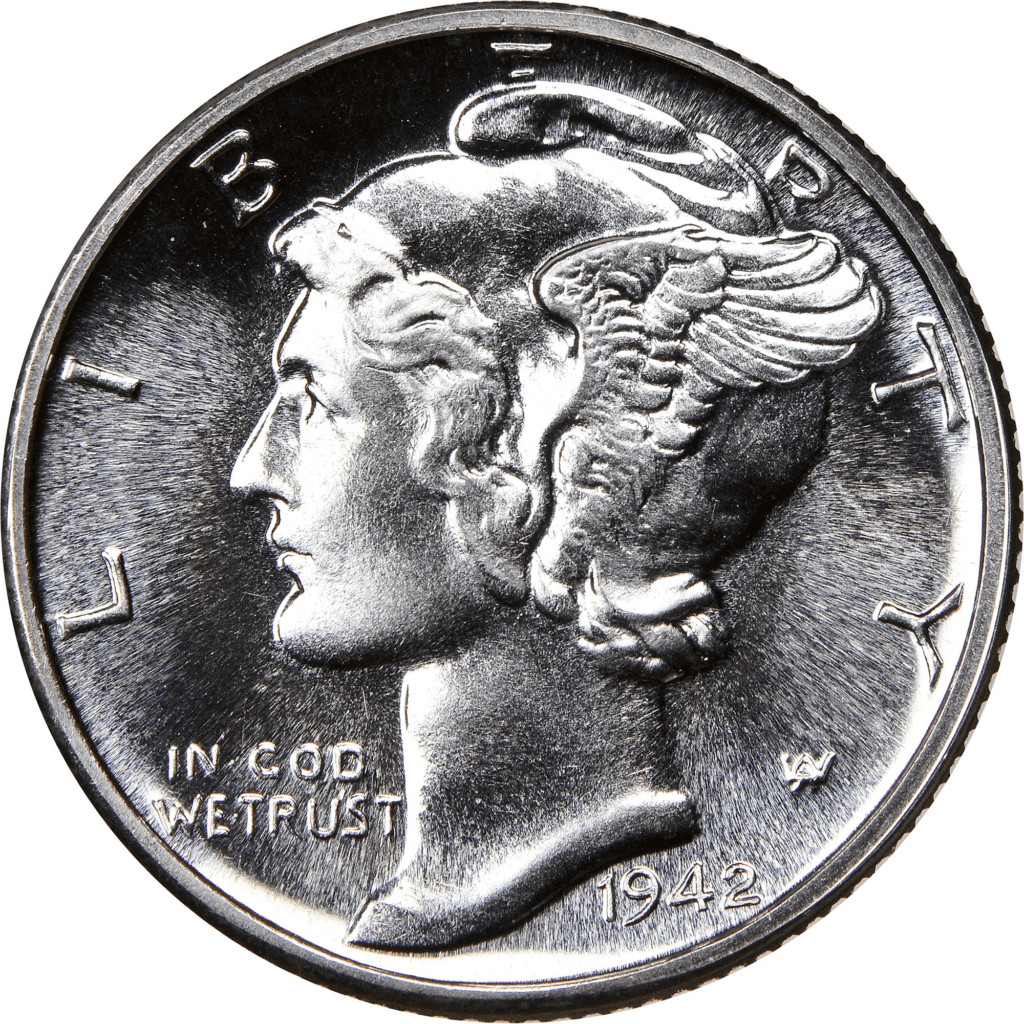
The Philadelphia Mint manufactured proof dimes in the same year in addition to circulation-only coins. Specifically, chosen dies and finely polished planchets were used to create the proofs. They were the last proofs of the Mercury dimes to be struck.
Because of the outbreak of World War II, 1942 was the last year of production for proof coins until 1950. The mint produced 22,329 proof Mercury dimes of the greatest quality this same year. It has a face value of $0.10 (ten cents).
1942 D Mercury Dime
Edge: Reeded
Mint Mark: none
Place of minting: Philadelphia
Year of minting: 1942
Face Value: $0.10 (ten cents)
Price: $2.22 to $4.70 (Circulated condition)
Quantity produced: 60,740,000
Designer: Adolph Alexander Weinman
Composition: 90% Silver and 10% Copper
Mass: 2.50 grams
Diameter: 90 millimeters
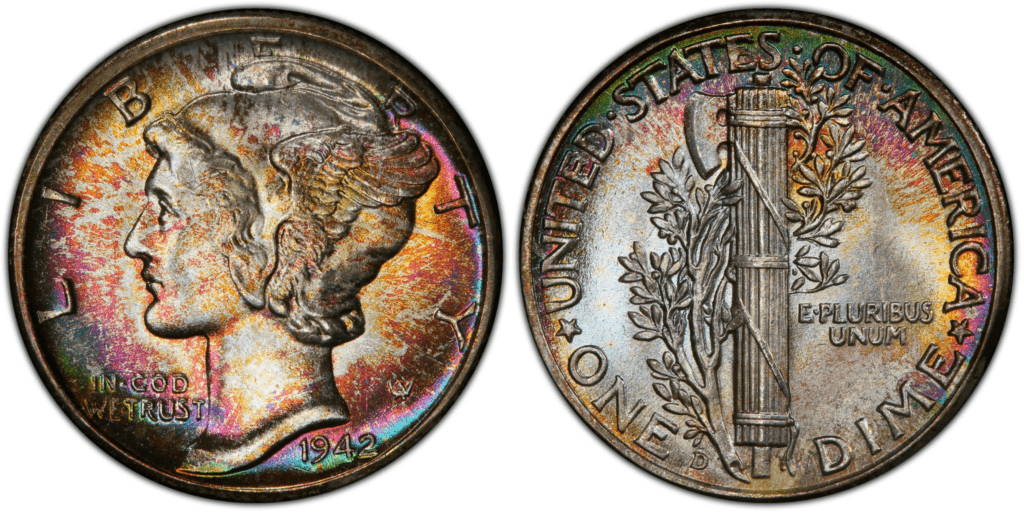
In 1942, the Denver Mint produced 60,740,000 Winged Liberty Head (Mercury) dimes. Because of this large number of coins created, thousands of pieces of this high-mintage wartime issue were kept in Mint State.
Despite making up a small portion of the survivors, these gems are plentiful enough to readily fill this void in anyone’s collection. Coins from the Denver Mint were the best struck of the three mints, hence Full Band pieces are very common. The 1942-D dime has more than a dozen repunched mint mark variations.
Early this year, the 1942 Mercury dime is valued between $2.50 and $4.50 (NGC Price Guide). However, the uncirculated ones in pristine condition could cost as much as $625 on the open market.
1942 S Mercury Dime
Edge: Reeded
Mint Mark: none
Place of minting: Philadelphia
Year of minting: 1942
Face Value: $0.10 (ten cents)
Price: $2.22 to $5.01 (Circulated condition)
Quantity produced: 49,300,000
Designer: Adolph Alexander Weinman
Composition: 90% Silver and 10% Copper
Mass: 2.50 grams
Diameter: 90 millimeters
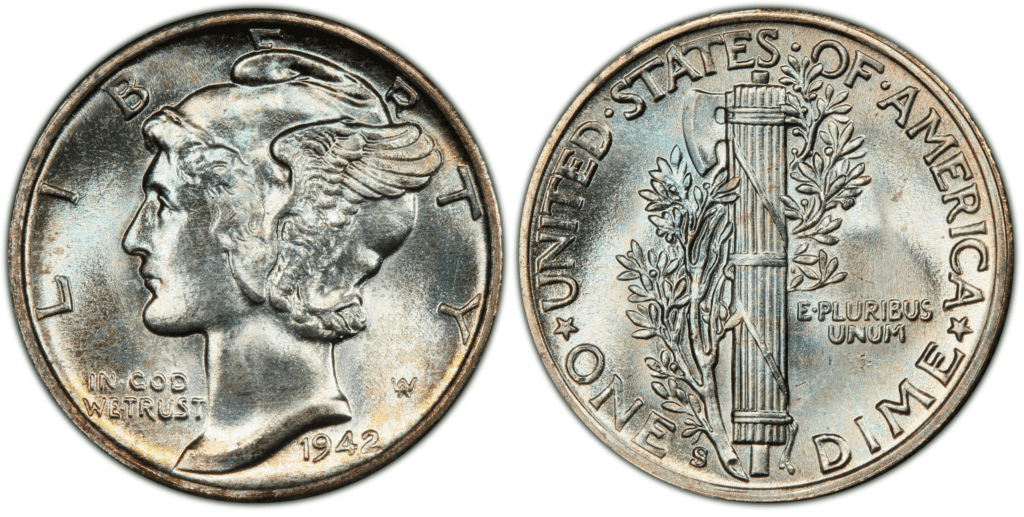
The San Francisco Mint produced 49,300,000 Winged Liberty Head (Mercury) dimes in 1942. Due to the generous wartime mintage of this issue and the widespread practice of collectors preserving fresh rolls by 1942, Mint State copies are easy to find.
Most specimens have somewhat weak centers, with Full Bands examples being rare. This issue, like most S-Mint coins from the 1940s, occasionally has brilliant fields due to rigorous die polishing to remove imperfections.
Many do not meet the requirements for the approved classification of PL (proof-like) since the dazzling regions frequently do not cover the entire field on both sides.
This year, two different “S” mint mark styles were used. Most 1942-S dimes retained the Trumpet Tail S of 1941, a new, Large S comparable to that used briefly in 1928 is also discovered in numbers high enough not to be uncommon. The Trumpet Tail S is present on all but one of the RPM varieties known for this problem, and a very minor DDR variety is shown in the Wexler/Flynn book.
At the time of this writing, the NGC Price Guide values a 1942 Mercury dime in circulated condition between $2.50 and $5.50. But did you know you can sell an uncirculated 1942 S Mercury dime in pristine condition for as much as $500? Imagine that!
List Of 1942 Mercury Dime Errors
There were more than 315 million mercury dimes issued in 1942. With this massive production volume, you can imagine that error coins were waiting to happen.
There are different error coins in the 1942 series of Mercury 10-cent coins. Here are some of them:
Overdate
Coins that have been overdated typically have the original date re-punched with a new digit. But although the 1942 dime is typically called an overdate, that’s not entirely true. In this instance, a die error is to blame for the date’s last “1” and the “2”.
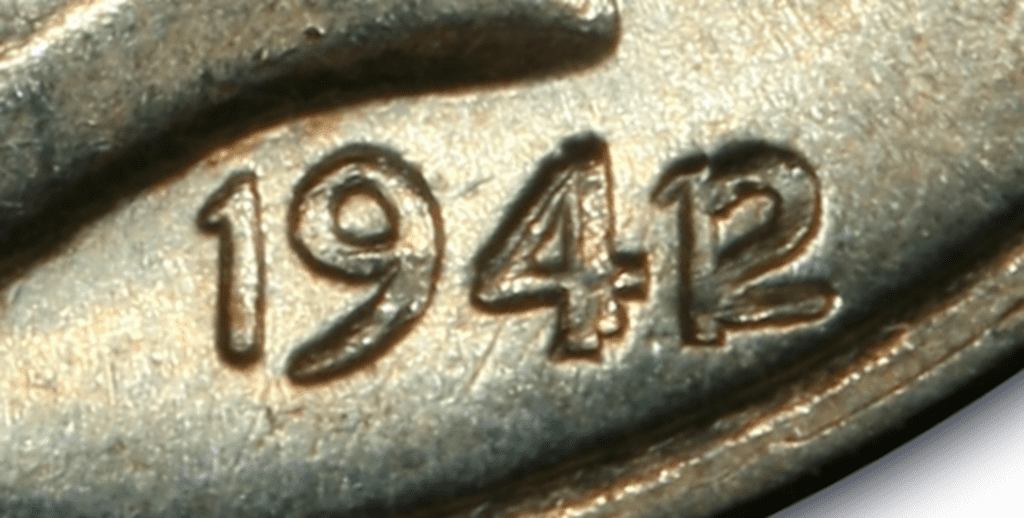
Repunched Mint mark (RPM) error
Some of the 1942 dimes minted in Denver have a repunched mint mark. Look closely, and you’ll see the shadow of the original mint mark at a small angle beneath the subsequent “D.”
Even samples of this coin that have been used can command high values. A cleaned coin rated AU55 (“Almost Uncirculated”) sold at auction for $630.
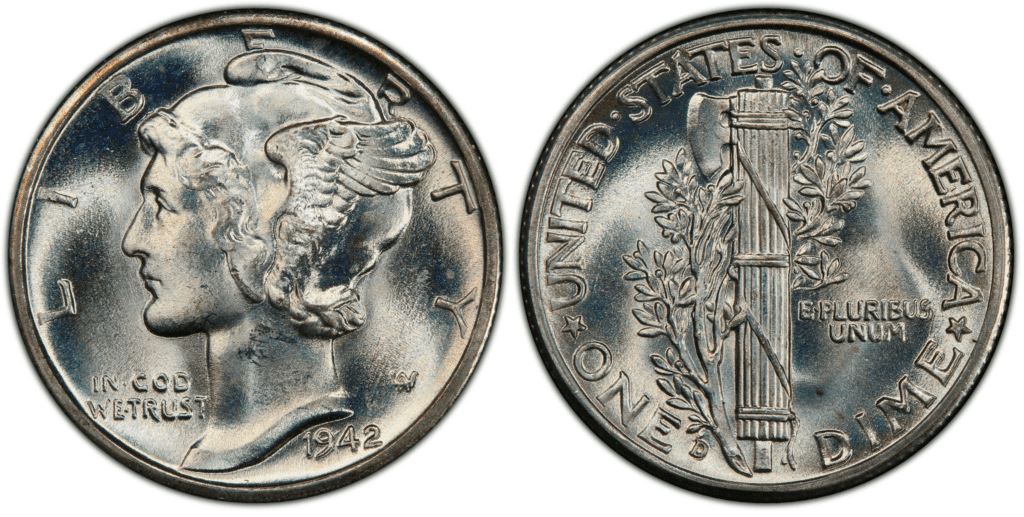
Planchet error
Throughout the Second World War, the United States kept minting coins for foreign governments, especially for allies and surrounding countries. The metal planchet, which served as the foundation for the intriguing error (shown below), is mostly brass-gold with hints of rose and plum.
The luster is strong, and though the planchet is approximately 20% underweight compared to the 2.5 gm standard for dimes of the era, the bands of the fasces exhibit full separation.
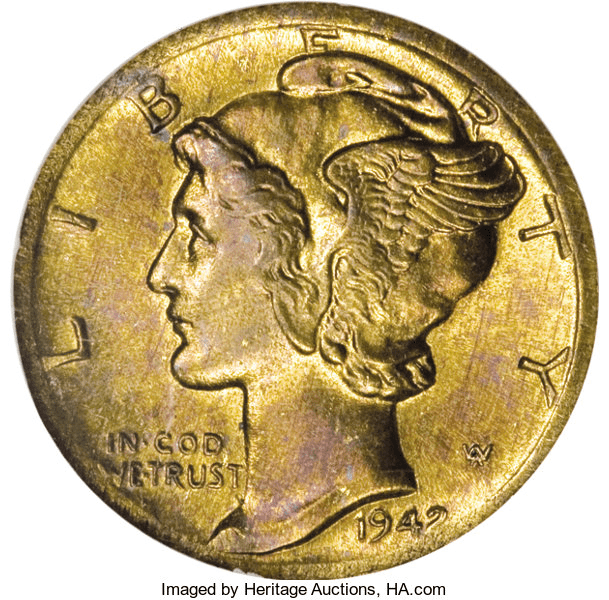
How Much Is The 1942 Mercury Dime Worth Today?
You need to consider different variables to estimate the nominal value of your 1942 Winged Liberty Head (Mercury) dime. If the coin is damaged, then its value will reduce.
The type of coin also matters when checking for its value. For instance, the Walking Liberty half dollars were struck in up to three different varieties each year. Therefore, its type will pose a significant impact on its value.
As of writing, the USA Coin Book estimated the value of the 1942 Mercury dime at $2.79 in Average Condition and $6.38 to $35 or more in Uncirculated (MS+) Mint Condition. Moreover, proof coins could reach values of up to $315. In relation, the NGC set its melt value at $1.75.
To give you an idea of how much the 1942 Mercury dimes were sold in the past, here’s a table of the auction records as shown on the website of PCGS:
| Variety | Condition | Grade | Date Sold | Auction record |
| 1943 Proof Mercury Dime | Superb Gem Uncirculated – Proof | PR69 | June 7, 2015 | $37,600 (Heritage Auctions) |
| 1943 P Mercury Dime | Superb Gem Uncirculated – Full Band | MS68 | May 16, 2019 | $15,275 (Legend Rare Coin Auctions) |
| 1943 S Mercury Dime | Superb Gem Uncirculated – Full Band | MS68 | January 26, 2014 | $14,750 (David Lawrence RC) |
| 1943 S Mercury Dime | Choice Uncirculated – Full Band | MS64 | July 30, 2003 | $9,488 (Bowers & Merena) |
How Does The Grading System Work?
The Sheldon Scale is used by numismatists to provide a numerical value to coins. The Sheldon Scale goes from poor (P-1) to perfect mint state (P-1) (MS-70). Coins were originally evaluated using words to reflect their condition (Good, Fair, Excellent, Etc.). Unfortunately, coin collectors and dealers had different ideas about what each of these terms represent.
Professional numismatists joined together in the 1970s and established CoinGrading standards. These numismatists now assign grades at key places on the seventy-point scale, using the most regularly utilized numeric points in conjunction with the original adjective grade. The following are the most common coin grades:
-
-
- (P-1) Poor – Indistinguishable and probably damaged; if used, must have a date and mintmark; otherwise, rather battered.
- (FR-2) Fair – Nearly smooth, but without the damage that a coin graded Poor often possesses. The coin must have enough detail to be identified.
- (G-4) Fair – Inscriptions have merged into the rims in some areas, and important elements have been mostly erased.
- (VG-8) Very Good- A little weathered, but all of the primary design elements are visible, albeit faintly. There is little if any, central detail left.
- (F-12) Good – The item is very worn, yet the wear is even, and the overall design details stand out clearly. Rims are almost completely isolated from the field.
- (VF-20) Very Fine – Moderately weathered, with some finer features still visible. The motto or all letters of LIBERTY are readable. Both sides of the coin have entire rims that are separated from the field.
- (EF-40) Extremely Fine – Gently used; all gadgets are visible, and the most important ones are bold. The finer details are bold and clear, however, light wear may be seen.
- (AU-50) Uncirculated – Slight evidence of wear on the coin’s design’s high points; may have contact marks; eye appeal should be adequate.
- (AU-58) Uncirculated Choice – Slight traces of wear, no severe contact marks, almost full mint shine, and great eye appeal.
- (MS-60) Mint State Basal – Strictly uncirculated; no indication of wear on the coin’s highest points, but an unsightly coin with reduced luster, visible contact marks, hairlines, and other flaws.
- (MS-63) Mint State Acceptable – Uncirculated, but with contact scratches and nicks, little reduced shine, but otherwise appealing appearance. The strike is weak to average.
- (MS-65) Mint State Choice – Uncirculated with great mint shine, very little contact blemishes, and exceptional eye appeal. The strike is unusually severe.
- (MS-68) Mint State Premium Quality – Uncirculated with superb luster, no obvious contact marks to the naked eye, and exceptional eye appeal. The strike is quick and appealing.
- (MS-69) Almost Perfect Mint State – Uncirculated with perfect brilliance, a sharp and appealing strike, and extremely good eye appeal. A near-perfect coin with minor imperfections in the planchet, strike, and contact markings (seen only under 8x magnification).
- (MS-70) Mint State Perfect – Under 8x magnification, there are no tiny imperfections discernible; the strike is crisp, and the coin is perfectly centered on a beautiful planchet. Rarely seen on a coin, this coin is bright and whole, with original luster and exceptional eye appeal.
-
Where To Buy Or Sell 1942 Mercury Dime?
Have you visited coin or antique shops when looking for a 1942 Winged Liberty Head (Mercury) dime? Because they might possess some! But finding them there is always more challenging.
So, if you’re looking for a simpler method, think about looking online. Amazon, Etsy, eBay, and Etsy are just a few examples of online markets and auction platforms that you can consider. You might stumble across merchants who sell rare coins if you’re lucky!
You can also tap experts and professionals from PCGS and NGC to help you with where and how to buy or sell your 1942 Winged Liberty Head (Mercury) dimes.
FAQs
How can you tell if you have a 1942/41 D Mercury dime?
You can tell if you have found a 1942/41 D Mercury dime if the coin’s mint mark is “D,” and you can see the number “1” in the year overdated with a number “2.”
What is the error on a 1942 Mercury dime?
There are different types of errors that you can find on a 1942 Winged Liberty Head (Mercury) dime. For instance, an Overdate, where the original date is re-punched with a new digit; Repunched Mint mark (RPM) error, wherein you can see the shadow of the original mint mark at a small angle beneath the more recently punched mint mark; or a Planchet error, wherein a different metal planchet is used to produce the coin.
Where is the mint mark on the 1942 Mercury dime?
If there is a mint mark (either “S” or “D”), you can see it around the torch’s lower-left rim. There will be no mint mark for the Mercury dimes minted in Philadelphia.
